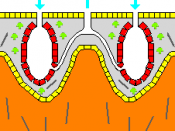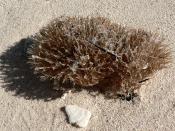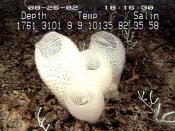INTRODUCTION:
Phylum Porifera is the simplest and is considered the most primitive of the multicellular animals.
NAME:
The word "Porifera" is derived from Latin.Porus means "pore" and ferra means "to bear".So,the Poriferas are pore-bearing animals,commonly called the
"sponges".
HABITAT:
All Poriferas are aquatic.Out of total 5000 species,150 species live in fresh water while all others are marine.
SIZE:
The Poriferas range in size from few millimeter wide to more than one meter tall.They are macroscopic i.e., can be seen with naked eye."Scolymastra joubini"-a barrel like glass sponge of Antarctica is more than a metre tall.
COMPOSITION:
These animals are composed of many cells,however,there is no tissue organization and have no organs.Sponges lack symmetry.
In most sponges,the body wall is formed of :
(1)an outer layer,pinacoderm,made up of cells called "pinacocytes" and,
(2)an inner layer,choanoderm,made of flagellated collar cells called "choanocytes".
Between these two layers is present gelatinous
"mesenchyme" which may contain amoeboid cells and spicules or sponginfibres.
Penetrating the pinacoderm are cylinderical cells called "sporocytes".
BODY CAVITY:
There is a single cavity inside the body,the
"spongocoel".In most sponges, this spongocoel may be divided into flagellated chambers or canals,lined by flagellated choanocytes.
CIRCULATION AND RESPIRATION:
Numerous pores are present in the body wall.The pores through which water enters the body are called "ostia" and pore through which the water leaves the body is known as "osculum"(main opening).There are no respiratory or circulatory organs.
NUTRITION:
Since the sponges are sessile,therefore,these depend
upon the food coming to them along with water currents brought about by movement of flagella of choanocytes.The food includes small animals called "zooplankton" and plants called "phytoplankton" which constitute about 20% of thier food.
80%of thier food consists of detrital organic particles. The food enters the spongocoel cavity through ostia. The food is...


